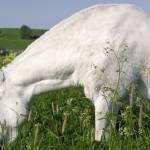Cushing’s and Age-Related Decline in Equine Reproductive Efficiency

Mares can successfully conceive and foal well into their third decade of life. According to a recent review on the subject*, the number of aged and even geriatric broodmares is anticipated to increase in the upcoming years because of the improved health and management of older horses.
Not surprisingly, increasing mare age is associated with increased fertility issues, and older mares have lower foaling rates than their younger counterparts. In addition to simply being “older,” underlying pituitary pars intermedia dysfunction (PPID, equine Cushing’s disease) is also thought to impact reproductive function in mares. The occurrence of PPID increases with age and is the most common endocrine disorder in horses in their late teens and older.
Although the detailed, overall impact of PPID on broodmare function has not been fully studied, researchers do know that the pars intermedia, located in the pituitary gland near the base of the brain, plays a role in “seasonality.” This explains the abnormal growth and shedding of the hair coat in many horses with PPID. Because mares are seasonally polyestrous, meaning they cycle when the daylight hours are long and become reproductively inactive when the daylight hours are short, it is not surprising the PPID would negatively impact breeding success in affected mares.
Experts currently recommend treating horses diagnosed with PPID with pergolide, yet the drug itself is also thought to negatively impact reproductive parameters.
“This treatment (pergolide) is likely to suppress prolactin secretion…suggesting that hypogalactia and agalactia are more likely to be problematic in lactating mares with PPID,” wrote Burns in a recent article*. Hypogalactia and agalactia refer to lactation deficiency or failure. Pergolide may also increase the risk of prolonged gestation and premature placental separation.
Current recommendations for managing broodmares with PPID include:
- Discontinue pergolide administration 30 days prior to the estimated foaling date;
- Monitor milk production and foal growth carefully after foaling. If necessary, supplement foals receiving inadequate nutrition from milk replacer, goat’s milk, milk-based creep feed, or a combination of these;
- Reinstitute pergolide approximately 30 days after foaling unless the mare does not respond well to cessation of pergolide (e.g., onset of laminitis). In such cases, pergolide can be reinstituted earlier assuming a nurse mare or alternate form of nutrition is available;
- Consider using mares with PPID as embryo donors instead of carrying foals to term; and
- Recall that some mares also have insulin resistance (IR) and should therefore be maintained at an appropriate body condition (a 5 or 6 on the Henneke nine-point scale) and fed forage low in nonstructural carbohydrates and higher in fat and fiber.
Kentucky Equine Research (KER) partners with specific feed companies and offers several products to provide optimal nutritional support for broodmares with PPID. For example, Re-Leve is a low-starch feed suitable for ensuring appropriate condition in thinner mares; the hindgut buffer EquiShure helps minimize laminitic episodes by stabilizing hindgut pH; and, Bio-Bloom PS (Bio-Bloom HF in Australia) supports hoof health. When in doubt, consult a KER nutritionist for help maximizing your mare’s diet.
*Burns, T.A. 2016. Effects of common equine endocrine diseases on reproduction. Veterinary Clinics of North America. Equine Practice. 32(3):435-449.








